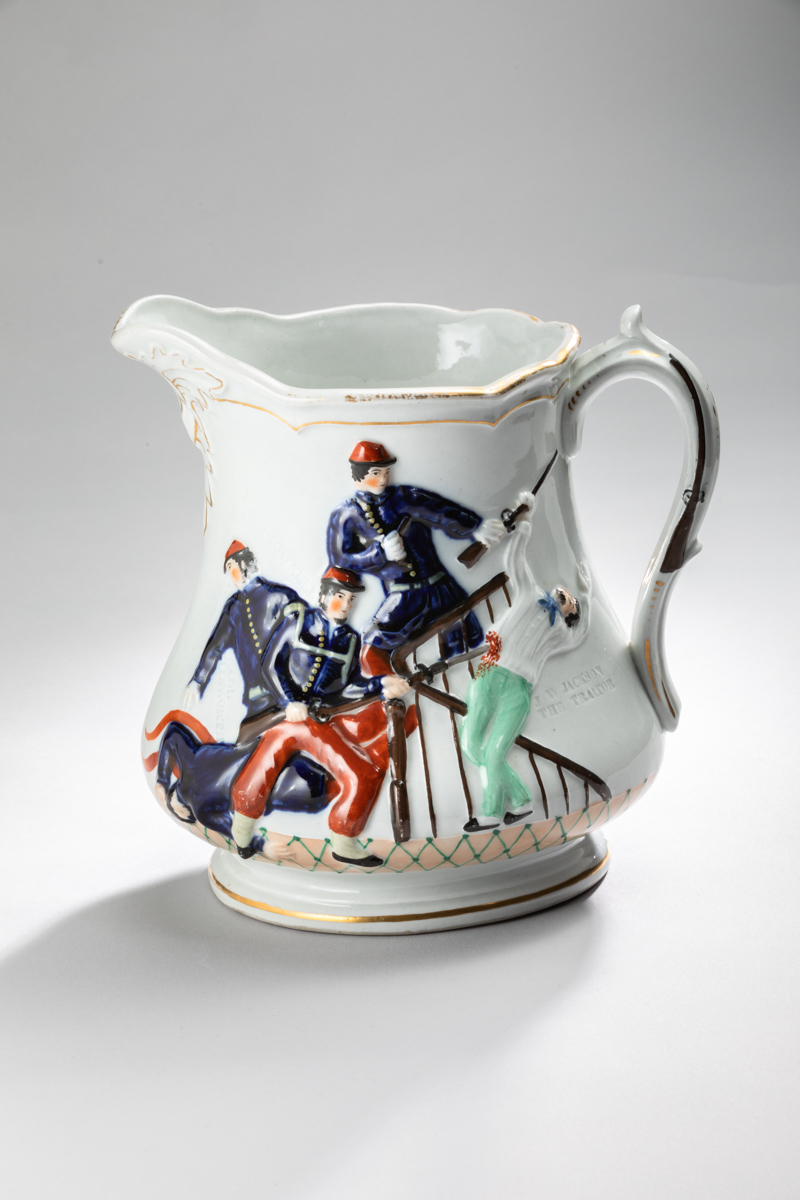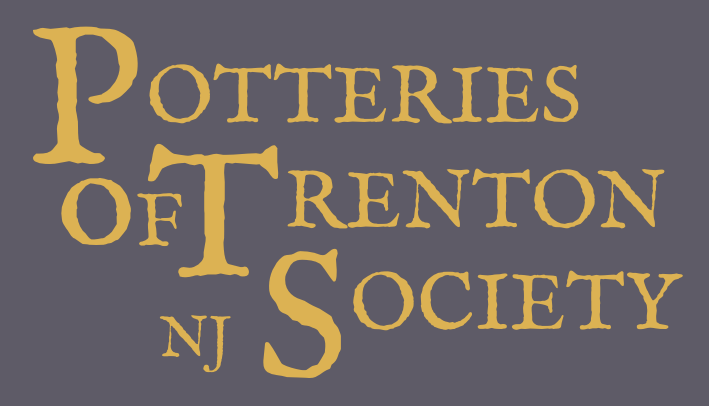
Recent events in Washington DC bring to mind a critical moment in another era and the emergence of what may be the first commemorative pitcher made in the United States. The object, known today as the Colonel Ellsworth Pitcher, commemorates a decisive moment in the opening of the Civil War on 24 May1861, when Ellsworth and his adversary, innkeeper and secessionist James Jackson, were killed in rapid succession after Ellsworth removed a rebel flag from the Marshall House, a hotel in Alexandria, Virginia. The Ellsworth Pitcher, designed and modeled by Charles Coxon, was made shortly thereafter in Trenton, New Jersey by Millington, Astbury and Poulson. The bright colors of this example were added by Coxon’s daughter, Ann Coxon Smith.
Elmer Ephraim Ellsworth (1837 – 1861), a United States Army officer, was the first conspicuous casualty and the first Union officer to die in the American Civil War, but it was his acrobatic performance and close association with Abraham Lincoln that fired the incident with popular sentiment. Born and raised in upstate New York, Ellsworth moved to Chicago in 1859, where he formed the United States Zouave Cadets. Under his command, the Cadets popularized the colorful Zouave uniform and acrobatic drill. After a six-week tour of Eastern cities during the summer of 1860, Ellsworth moved to Springfield, Illinois, and joined Abraham Lincoln’s law office, where he became a favorite of Lincoln’s. As hostilities grew between the states after Lincoln’s election, Ellsworth recruited a Zouave regiment in New York City—the “1st New York Fire Zouaves,” or the 11th New York Volunteers—from the city’s volunteer firemen.
On May 24, the Fire Zouaves were sent to Alexandria VA to retrieve the city from the hands of the rebels. Union troops had surprised and captured the city just before dawn, when Ellsworth set his sights on the rebel flag atop the dingy old Marshall House hotel, which could be seen from the White House. He had no trouble taking the flag, but as he descended the stairs he encountered innkeeper Jackson and was felled by a shotgun blast to his chest. Jackson was killed immediately by Cpl. Francis Brownell, one of Ellsworth’s troops. A vivid firsthand account of the events published in Trenton’s Daily True American of May 28 confirms the outline of this story. Corporal James M. Brannin of Monmouth County NJ was with the Colonel on that fateful day:
I, belonging to Company A, was one of the first to land. The Colonel marched our company up the street about 400 yards and halted. He then took the four Corporal’s from the right of Company A (myself included) and started for the telegrahic office. After arriving there, we saw a secession flag flying from the top of a hotel some distance up the street. Our Colonel concluded to go up and take it down. We entered the hotel, proceeded up to the roof, cut down the flag, and started down the stairs, the Colonel ahead the flag in his arms. When we reached the second landing, the proprietor, whose name was Jackson, and who was the leading secessionist of the city, and the same man that cut off John Brown’s ear after he was hung, jumped out of a room, presented the muzzle of a double-barrel gun at the Colonel, killing him instantly: he then aimed his piece at me, but before he could fire, fell dead with a shot through the brain from Corporal Brownell’s rifle, and thrust through the body from my bayonet.
Ellsworth’s death devasted President and Mrs. Lincoln. In a memorial to Ellsworth’s parents, Lincoln wrote “In size, in years, and in youthful appearance, a boy only, his power to command men, was surpassingly great– This power, combined with a fine intellect, an indomitable energy, and a taste altogether military, constituted in him, as seemed to me, the best natural talent, in that department, I ever knew.”
A reporter for Harper’s Weekly happened to be in Alexandria at the time, and his front-page illustrated story in the 15 June 1861 issue caught the public’s attention. In addition, southern Confederates raised up Jackson as a martyr for their cause. Indeed, some historians say that the tragic encounter between Ellsworth and Jackson did more to sway public opinion on both sides toward conflict between the states than the incident at Fort Sumter in early April.
In the North, Ellsworth’s untimely death engendered myriad memorials. Marches and songs published as sheet music with pictorial covers, as well as the illustrated stories in Harper’s Weekly and popular prints from Currier & Ives, among others, offered sources of illustration to many artists and designers hoping to capitalize on the tragedy. In Trenton, New Jersey, pottery owners Millington, Astbury and Poulson commissioned modeler Charles Coxon to create a bar pitcher commemorating the event.
The press-molded pear-shaped pitcher depicts the incident in low relief. The animated scene, perhaps based on the front-page illustration in Harper’s Weekly, captures the basic elements of the story: Ellsworth’s dead body at the foot of the stairs and Brownell’s subsequent attack on Jackson. Impressed titles identify the players. “J W JACKSON / THE TRAITOR” is shown on the far right of the scene. “COL ELLSWORTH” and “F E BROWNELL” are also identified. On the reverse, various symbolic motifs are shown also in low relief under the title “UNION AND THE CONSTITUTION.” A gilded eagle attacks a serpent wrapped around an uprooted palmetto tree with a rebel flag on a broken flag pole. A cluster of muskets supports an American flag.
The firm of Millington, Astury and Poulson included Richard Millington (b. England ca. 1818 – d. Trenton 1882), who was in America by the early 1850s when he worked in the factory of Charles Cartlidge at Greenpoint (Brooklyn), New York. He and John Astbury, an English potter and associate at Cartlidge’s pottery, joined Trenton’s Young family of potters in 1853 to assume operational responsibilities for the Excelsior Pottery. The firm operated as Young & Company from 1853 to 1860 when Millington and Astbury sold their interest to the Youngs and joined Theophilus Poulson of Philadelphia in a partnership to build a new pottery on Carroll Street as Millington, Astbury & Poulson (1860-65). These companies were the first of Trenton’s potteries to make white ware or granite ware that competed successfully with English ironstone.
In the late 1800s, the ceramic history scholar Edwin Barber identified Josiah Jones as the modeler of this still famous pitcher. However, collector and scholar David Goldberg’s research has shown that Charles Coxon was the designer and modeler in June 1861. Coxon (1805-1868), who came from a family of potters, started working life at a young age as an apprentice in the local potteries of Staffordshire. Charles and his wife Mary with their seven children lived in Longton, Staffordshire, the heart of the English pottery district. Charles’ brother William emigrated to America in 1844; Charles followed with his wife and five of their seven children in 1849 from Liverpool to New York City aboard the steamship Rappahannock. The family first lived in New Jersey near brother William and his family. Soon after their arrival, Charles went to Baltimore to find work and his family joined him later according to the 1850 US Census. Charles and his eldest son John found work at the large Edwin Bennett Pottery Company there. The Coxons were initially employed as pressers – shaping pottery by pressing slabs of damp clay between two halves of a mold. Eventually Charles became the designer and modeler for the Bennett Pottery producing an impressive body of work. (For illustrations of Coxon’s work for American potteries, see David Goldberg, “Charles Coxon: Nineteenth-Century Potter, Modeler-Designer, and Manufacturer,” American Ceramic Circle Journal, IX, pp. 29-64.) Both Charles and son John were working in Trenton’s potteries by early 1861; and Charles established his own pottery here in 1863.
Most examples of this pitcher that survive are glazed ironstone, but not decorated. The china colors would have required additional firings and greater expense. The colors also required having an expert glaze craftsman to attend the making process. Goldberg found in his research that Coxon’s daughter Ann Coxon Smith was the decorator of MAP’s small production of this pitcher.
Commemorative objects help users remember events or persons of significance. Many are made in useful forms, but are often used only for display. The Ellsworth Pitchers would have been used on tavern bars to hold water for mixing with whisky or were used for dispensing beer. In this primarily male environment the reminder of the Alexandria conflict would have encouraged Union patriotism during the conflict between the states.
The Colonel Ellsworth Pitcher, 1861, 9 in H, designed by Charles Coxon (1805-1868), made by Millington, Astbury & Poulson (1860-1865), Trenton, NJ, decorated in colors by Anne Smith Coxon, Coxon’s daughter. The pitcher is marked M.A.P./TRENTON/N.J. in an oval. Collection of the New Jersey State Museum, Museum Purchase CH1971.192. Photograph by Ricardo Barros.
— Ellen Denker
Photographed as part of a collaborative project with the New Jersey State Museum. The project was made possible, in part, by a grant from the Mercer County Division of Culture and Heritage, in partnership with the New Jersey Historical Commission, Division of Cultural Affairs/ Department of State.
